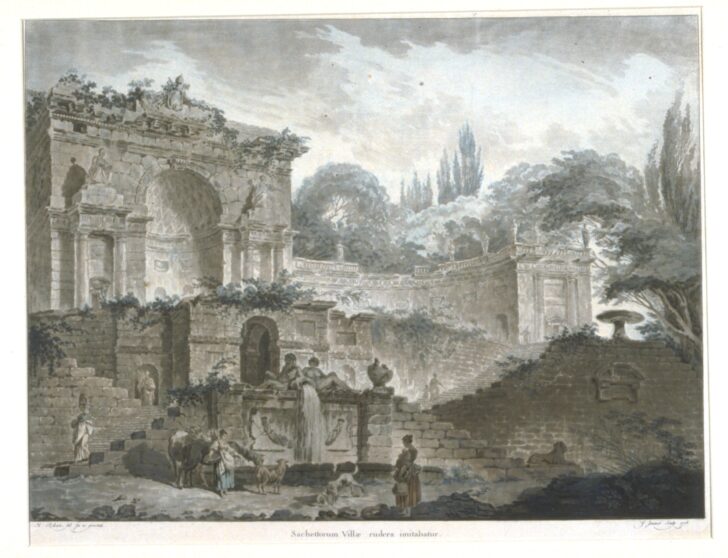Fontaine de la Villa Sacchetti
Jean-François Janinet

Description
The avid taste among collectors for works by important artists led to the creation of new media that could provide facsimiles of original drawings and watercolors to an eager public. By covering the plate with a fine pattern of marks that approximate the opacity and translucency of the Robert gouache without resorting to harsh outline, Janinet devised a manner by which he could evoke the delicate washes of the original. Although the tonal gradations appear to be aquatint, Janinet employed a variety of stipple tools and roulettes in a process that is a further refinement of crayon-manner engraving. The rich color prints shown here, a combination of etching and crayon-manner engraving, illustrate why color printing during this period in France was so highly regarded.
Jean-François Janinet was largely known as a reproductive engraver. These two works depicting Roman monuments are based on gouaches by the artist Hubert Robert; the original drawings were part of the renowned collection of P.J. Mariette. Janinet is sometimes credited with introducing color printing in France, although color printing first became popular in Paris through the works of Janinet’s teacher, Louis-Marin Bonnet. Janinet’s most talented pupil, Charles-Melchior Descourtis, also made his name creating colored prints after watercolor and gouache originals, such as the Noce de Village and Foire de Village, on view elsewhere in the gallery.
Although closely resembling aquatint, the work of Jean-François Janinet and his pupil Charles-Melchior Descourtis is actually an extension of crayon-manner engraving. Rather than using a resin to create the fine tonal qualities desired, as is the case in aquatint, both Janinet and Descourtis used a series of fine rockers and stippling tools (sometimes through a ground) to create the delicate tonalities found in their color prints. See 1973/1.736 and 737 and also 1974/2. 48 and 49. [Source: Grove Dictionary of Art and Regency to Empire: French Printmaking 1715-1814, Baltimore Museum of Art, 1985]
Exhibition label copy from "Eighteenth Century French Prints and Drawings," February 1 - May 4, 2003 by Curator Carole McNamara
Usage Rights:
If you are interested in using an image for a publication, please visit https://umma.umich.edu/request-image/ for more information and to fill out the online Image Rights and Reproductions Request Form.